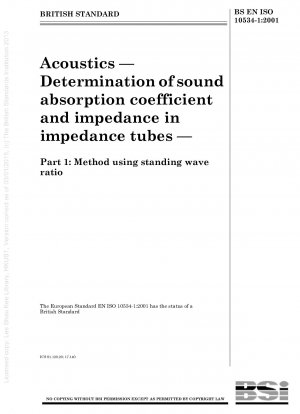BS EN ISO 10534-1:2001
Acoustics - Determination of sound absorption coefficient and impedance in impedances tubes - Method using standing wave ratio
- Standard No.
- BS EN ISO 10534-1:2001
- Release Date
- 2001
- Published By
- British Standards Institution (BSI)
- Latest
- BS EN ISO 10534-1:2001
- Scope
- 1 This part of ISO 10534 specifies a method for the determination of the sound absorption coefficient, reflection factor and surface impedance or surface admittance of materials and objects. The values are determined for normal sound incidence by evaluation of the standing wave pattern of a plane wave in a tube, which is generated by the superposition of an incident sinusoidal plane wave with the plane wave reflected from the test object. This method can be used for the determination of the sound absorption coefficient of sound absorbers for normal sound incidence. It can further be used for the determination of the acoustical surface impedance or surface admittance of sound-absorbing materials. It is well suited for parameter studies and for the design of sound absorbers, because only small samples of the absorber material are needed. 2 There are some characteristic differences be-tween this method and the measurement of sound absorption in a reverberation room (see ISO 354). The impedance tube method can be used for the de-termination of the reflection factor and also the im-pedance or admittance. The sound is incident normally on the object surface. The reverberation room method will (under idealized conditions) determine the sound absorption coefficient for random sound incidence. The impedance tube method relies on the existence of a plane incident sound wave and gives exact values under this condition (measuring and mounting errors excluded). The evaluation of the sound absorption co-efficient in a reverberation room is based on a number of simplifying and approximate assumptions concern-ing the sound field and the size of the absorber. Sound absorption coefficients exceeding the value 1 are therefore sometimes obtained. The impedance tube method requires samples of the test object which are the size of the cross-sectional area of the impedance tube. The reverberation room method requires test objects which are rather large and can also be applied to test objects with pro-nounced structures in the lateral and/or normal direc-tions. Measurements with such objects in the impedance tube must be interpreted with care (see 9.1). For the computational transformation of the test re-sults from the impedance tube method (normal inci-dence) to the situation of diffuse sound incidence, see annex D. 3 This part of ISO 10534 gives preference to nu-merical methods of evaluation instead of graphical methods, because computers which can perform these computations are assumed to be available. Some of the quantities in the formulae are complex. The arguments of trigonometric functions are in radians.
BS EN ISO 10534-1:2001 history
- 2001 BS EN ISO 10534-1:2001 Acoustics - Determination of sound absorption coefficient and impedance in impedances tubes - Method using standing wave ratio
